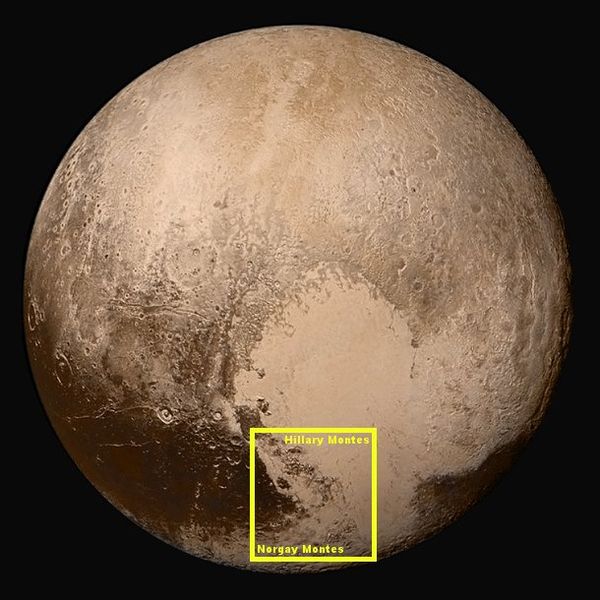The Tenzing Montes are a range of icy mountains on Pluto, bordering the southwest region of Sputnik Planitia and the nearby Hillary Montes and Wright Mons. With peaks reaching 6.2 km in height, they are the highest mountain range on Pluto, and also the steepest, with a mean slope of 19.2 degrees.
The Tenzing Montes as viewed by New Horizons on 14 July 2015.
Pluto – Hillary Montes and Tenzing Montes (context; 14 July 2015).
Hillary Montes and Tenzing Montes (context; 14 July 2015).
Hillary Montes and Tenzing Montes on Pluto (context; 14 July 2015).
Sputnik Planitia is a large, partially glaciated basin on Pluto. About 1,400 by 1,200 km in size, Sputnik Planitia is partially submerged in large, bright glaciers of nitrogen ice. Named after Earth's first artificial satellite, Sputnik 1, it constitutes the western lobe of the heart-shaped Tombaugh Regio. Sputnik Planitia lies mostly in the northern hemisphere, but extends across the equator. Much of it has a surface of irregular polygons separated by troughs, interpreted as convection cells in the relatively soft nitrogen ice. The polygons average about 33 km (21 mi) across. In some cases troughs are populated by blocky mountains or hills, or contain darker material. There appear to be windstreaks on the surface with evidence of sublimation. The dark streaks are a few kilometers long and all aligned in the same direction. The planitia also contains pits apparently formed by sublimation. No craters were detectable by New Horizons, implying a surface less than 10 million years old. Modeling sublimation pit formation yields a surface age estimate of 180000+90000−40000 years. Near the northwest margin is a field of transverse dunes, spaced about 0.4 to 1 km apart, that are thought to be composed of 200-300 μm diameter particles of methane ice derived from the nearby Al-Idrisi Montes.

New Horizons mosaic of the Sputnik Planitia basin





